#Astrobotic Technology
Text
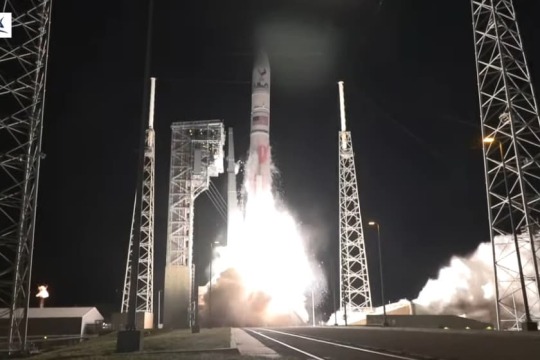
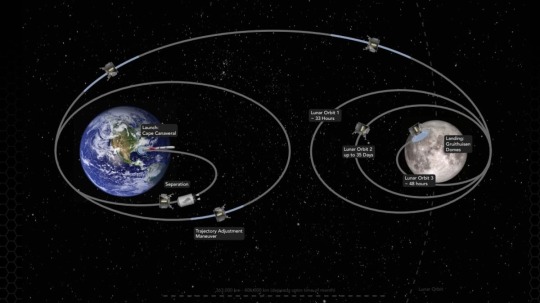
Peregrine launch sees US on way to the Moon after five decades
By David Szondy
January 07, 2024
The first US Moon landing mission in 52 years is on its way after Astrobotic’s Peregrine Mission One (PM1) lifted off this morning from Launch Complex-41 at Cape Canaveral Space Force Station in Florida atop a ULA Vulcan rocket at 2:18 am EST.
Under cloudy skies, the launch of PM1 took place without major delays or incidents. At one minute 16 seconds into the flight, the Vulcan/Centaur launcher reached maximum dynamic pressure. Reaching the one-minute-50-second mark, the solid rocket boosters separated from the Vulcan core stage. At the four-minute-59 second mark, the two first stage liquid fuel engines shut down, with stage separation following six seconds later.
The second stage then ignited and burned for two additional engine burns. After the Centaur stage shut down, the Peregrine spacecraft separated at 50 minutes into the flight.
The Centaur stage then fired again, sending it into a heliocentric orbit where it deployed the Celestis Memorial Spaceflight’s "Enterprise Flight" payload, which carries the cremated remains or DNA of a number of celebrities, including Gene and Majel Roddenberry, Nichelle Nichols, DeForest Kelley, and James Doohan. Peregrine also has the remains or DNA of 66 other individuals as part of the Celestis "Tranquility Flight" to the lunar surface.
As the Peregrine lander's systems powered up, contact was established with Astrobotic’s Mission Control Center, which will oversee operations from now on as Peregrine embarks on its 17-to-19-day cruise phase to lunar orbit during which it will orbit the Earth once before inserting into a lunar transfer orbit.
On reaching lunar orbit, Peregrine will carry out a series of orbital maneuvers to bring it closer to the lunar surface for up to 39 days until it gets the green light to land sometime in February 2024 at Sinus Viscositatis next to the Gruithuisen Domes on the northeast border of Oceanus Procellarum. This is an area of particular interest to geologists and it is hoped that the domes, which were formed out of granite-like substances, may shed light on the presence of water under the lunar surface or trapped in minerals.
Also onboard Peregrine are 20 payloads. Five of these are NASA experiments sent as part of the Artemis program and 15 more from international organizations. One of these is the Iris Lunar Rover built by Carnegie Mellon University. This means the PM1 is not only the first US lunar landing mission in over half a century and the first using a privately owned and operated spacecraft, it is also the first American mission to carry a lunar robotic rover.
The video below recaps the launch of PM1.
Source: New Atlas
#science#space exploration#moon#lunar landing#NASA#Peregrine Mission One#Peregrine Lunar Lander#Astrobotic Technology#ULA#Gene Roddenberry#Majel Barrett-Roddenberry#Nichelle Nichols#James Doohan#DeForest Kelley
4 notes
·
View notes
Text
ICYMI, The private company that angered the Navajo Nation by launching human ashes and DNA to the moon for cash was forced to abandon the project and bring the rocket back to Earth to burn up in the atmosphere.
[Edit: due to technical failures, not, you know, respect for anything]
0 notes
Text
Congratulations to United Launch Alliance and Jeff Bezos for the successful launch of the new Vulcan Centaur rocket carrying the Peregrin lander on a journey to the moon. The Vulcan was equipped with BE4 engines, which appeared to operate flawlessly!
0 notes
Text
Blue Origin selected as NASA’s 2nd Moon lander provider for Artemis
A rendering of the Blue Moon Human Landing System on the Moon for NASA’s Artemis program. Credit: Blue Origin
A team led by Blue Origin has been selected by NASA to build a second Human Landing System for the agency’s Artemis program.
Continue reading Untitled
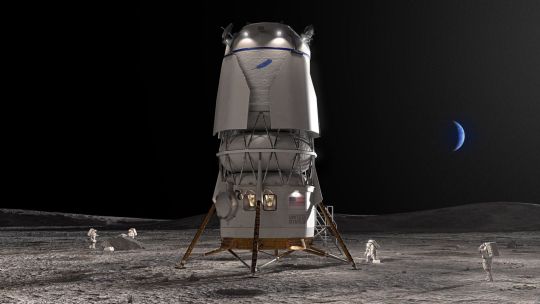
View On WordPress
#Artemis 5#Artemis program#Astrobotic Technology#Blue Moon#Blue Origin#Boeing#Draper#Lead Stories#Lockheed-Martin#NASA
0 notes
Text
More than 50 years after the last Apollo mission, the United States will try once again to land a craft on the Moon on January 25, said the head of what could be the first private company to successfully touch down on the lunar surface.
The lander, named Peregrine, will have no one on board. It was developed by American company Astrobotic, whose CEO John Thornton said it will carry NASA instruments to study the lunar environment in anticipation of NASA's Artemis manned missions.
Several years ago, NASA opted to commission US companies to send scientific experiments and technologies to the Moon – a program called CLPS.
These fixed-price contracts should make it possible to develop a lunar economy, and provide transport services at a lower cost.
"One of the big challenges of what we're attempting here is attempting a launch and landing on the surface Moon for a fraction of what it would otherwise cost," said Thornton Wednesday at a press briefing at his company's base in in Pittsburgh.
Continue Reading.
149 notes
·
View notes
Text
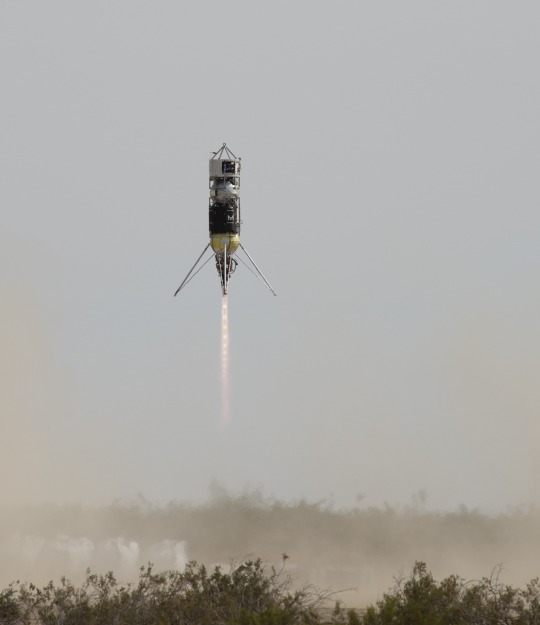
Xodiac Suborbital Rocket-Powered Lander
Astrobotic Technology Inc., Pittsburgh, Pennsylvania
Xodiac is a vertical-takeoff vertical-landing testbed for simulating lunar and planetary landings as well as a variety of other technology applications for space exploration.
image credit: Lauren Hughes/NASA
25 notes
·
View notes
Text

https://www.reuters.com/world/middle-east/israel-shifts-deadlier-strikes-iran-linked-targets-syria-2024-01-08/
3 notes
·
View notes
Link
It’s been another great year at NASA’s Ames Research Center in California’s Silicon Valley. Join us as we review some of the highlights of the science, engineering, and innovation from 2023. Announcing a New Innovation Hub Planned for NASA Research Park at Ames NASA Berkeley Space Center is a proposed new campus of the University of California, Berkeley, and an innovation hub for research and advances in astronautics, aeronautics, quantum computing, climate studies, and more. Planning to join Ames as a tenant of our NASA Research Park in Silicon Valley, the new campus aims to bring together researchers from the private sector, academia, and the government to tackle the complex scientific, technological, and societal issues facing our world. Mapping Water Distribution on the Moon’s South Pole NASA Using data collected by the now-retired Stratospheric Observatory for Infrared Astronomy (SOFIA), researchers shared the first detailed, wide-area map of water distribution on the Moon. Understanding how much water lies beneath the lunar surface, and how it’s distributed, will help guide future missions like VIPER, as well as prospective sites for human habitats. Colliding Moons May Have Formed Saturn’s Rings NASA New research suggests Saturn’s icy moons and rings were formed by a collision a few hundred million years ago, creating debris that gathered into the planet’s dusty, icy rings or clumped together to form moons. NASA and Airlines Partner to Save Fuel and Reduce Delays NASA/James Blair This year, NASA partnered with five major U.S. airlines on an air traffic decision-making tool that saved more than 24,000 pounds of jet fuel in 2022 for flights departing from Dallas-Fort Worth International Airport and Dallas Love Field Airport. Partners include American Airlines, Delta Air Lines, JetBlue Airways, Southwest Airlines and United Airlines. NASA Leaders View Climate Science, Wildfire Innovations at Ames NASA/Dominic Hart NASA’s top leadership, industry experts, and legislative officials visited Ames in April to learn about about the center’s climate science efforts and innovations in aeronautics that will help scientists and engineers better understand climate change and mitigate natural disasters like wildland fires. Starling Takes Flight Blue Canyon Technologies/NASA In July NASA’s Starling mission, managed at Ames, launched four CubeSats into low-Earth orbit to test robotic swarm technologies for space. You can track mission milestones via the Small Satellite Missions blog, and follow the mission live in NASA’s Eyes on the Solar System 3D visualization. NASA’s First Robotic Moon Rover NASA/Robert Markowitz This year engineers began assembling NASA’s first robotic Moon rover, VIPER — short for the Volatiles Investigating Polar Exploration Rover — and the agency is giving the public a front row seat to watch along as the rover takes shape. While individual components, such as the rover’s science instruments, lights, and wheels, were assembled and tested, the VIPER team also completed software development, mission planning, and tricky tests of the rover’s ability to drive off the Astrobotic Griffin lunar lander and onto the lunar surface. Bringing Home Ancient Space Rocks NASA/Keegan Barber NASA’s OSIRIS-REx mission – short for the Origins, Spectral Interpretation, Resource Identification, and Security-Regolith Explorer – returned to Earth in Sept. 2023, bringing with it extraterrestrial rocks and dust that it scooped up from an asteroid estimated to be 4.5 billion years old. Ames contributed to the spacecraft’s heat shield, anti-contamination systems, post-landing sample curation, and more. Preparing to Send Yeast to the Moon’s Surface for Astronaut Health NASA/Dominic Hart NASA’s plans to explore the Moon and eventually go to Mars will bring humans deeper into space for longer duration missions than ever before. These extended missions beyond low Earth orbit pose certain health risks to astronauts. The Lunar Explorer Instrument for Space Biology Applications team is preparing an experiment to study yeast’s biological response to the lunar environment to help understand and mitigate health risks for astronauts. X-59 Team Moves Toward First Flight in 2024 Lockheed Martin/Gary Tice This year, NASA’s X-59 team installed the finishing touches to the aircraft’s tail structure and moved it from its assembly facility to the flight line to perform structural testing. The X-59 quiet supersonic aircraft will take its first flight in 2024. Celebrating a Stellar Year for Webb Telescope Science NASA, ESA, CSA, STScI, and S. Crowe (University of Virginia) The James Webb Space Telescope’s Near-Infrared Camera instrument produced a feast for the eyes with a view into a star-forming region, named Sagittarius C, in the heart of the Milky Way. The image reveals a portion of the dense center of our galaxy in unprecedented detail, including never-before-seen features astronomers have yet to explain. Supercomputer Simulations Lead to Air and Space Innovations NASA Simulations and models developed using technology at the NASA Advanced Supercomputing Facility (NAS) help researchers and engineers develop innovations in air and space. Modeling turbofan engines could lead to designs that reduce engine noise and improve efficiency by understanding where noise is generated inside the machine. S-MODE Sails the Seas and Soars through the Sky NASA/Avery Snyder The Sub-Mesoscale Ocean Dynamics Experiment (S-MODE) logged its final field expedition, and they took a team from the TODAY Show along for the ride. S-MODE combined airborne instruments, research ships, and autonomous ocean gliders to get an unprecedented look at how gas and heat exchange at the ocean’s surface impacts Earth’s climate. From Intern to Astronaut, and Back to Ames NASA/Dominic Hart NASA astronaut Jessica Watkins, who was once an intern at Ames, returned to the Bay Area in Feb. 2023 to visit with local elementary schools and speak with Ames employees. Watkins started her career with NASA at Ames, where she conducted research on Mars soil simulant supporting the Phoenix Mars Lander mission. Second Gentleman Joins East Bay Kids for STEM Activities NASA/Dominic Hart Nearly 100 East Bay kids and their families got to experience the thrill of “launching a rocket” and “making clouds” at a fun-filled STEM event hosted in honor of Women’s History Month at the East Oakland Youth Development Center in Oakland, California, in March 2023. Second Gentleman Douglas Emhoff, NASA Ames Research Center Director Dr. Eugene Tu, and NASA astronaut Dr. Yvonne Cagle joined kids at the Manzanita Community School for hands-on activities and to distribute approximately 500 STEM Artemis Learning Lunchboxes aimed to inspire the Artemis generation to learn about NASA’s Artemis Program. Top Leaders in Our Midst Hailed from the White House and Australia NASA/Dominic Hart In January, U.S. President Joe Biden landed at Moffett Federal Airfield, at Ames, on his way to visit storm-damaged regions in the state. Research conducted at our Silicon Valley center could help predict extreme climate-related weather events. Later in the spring, Vice President Kamala Harris arrived at Moffett before delivering remarks at a local company, and leaders of the Australian Space Agency visited Ames to learn about the center’s missions supporting NASA’s Artemis program, including the VIPER Moon rover, which will launch to the lunar South Pole in late 2024.
2 notes
·
View notes
Text
2023 Space and Astronomy News: What to Expect
https://sciencespies.com/space/2023-space-and-astronomy-news-what-to-expect/
2023 Space and Astronomy News: What to Expect

As years in space and astronomy go, 2022 is going to be a tough act to follow.
NASA wowed us with cosmic scenes captured by the James Webb Space Telescope. The DART mission slammed an asteroid into a new orbit. Artemis I set humanity on a course back to the moon. China finished building a new space station in orbit. SpaceX launched 61 rockets in 12 months. And the invasion of Ukraine imperiled Russia’s status as a space power.
It’s a lot to measure up to, but 2023 is bound to have some excitement on the launchpad, the lunar surface and in the sky. Once again, you can get updates on your personal digital calendar by signing up for The New York Times’s Space and Astronomy Calendar. Here are some of the major events you can expect. Not all of them have certain dates yet, but Times journalists will provide additional information as it emerges. Learn more at nytimes.com/spacecalendar
New Rockets
NASA got its giant Space Launch System off the ground for the first time in 2022, lighting up the night in Florida with an incredible stream of flame as it carried the Artemis I mission toward the moon. That shifted attention to SpaceX, which is building a next generation rocket, Starship, that is also central to NASA’s crewed Artemis III moon landing attempt.
SpaceX cleared a key environmental review that would allow it to launch an uncrewed orbital test flight from South Texas if it met certain conditions. But the rocket wasn’t ready for flight in 2022. The company has not announced a date for a test this year, but regular ground tests of Starship equipment indicate it is working toward one.
The pathfinder first stage of the Vulcan Centaur, a new rocket by United Launch Alliance that will eventually replace that company’s Atlas V.United Launch Alliance
Numerous other rockets may take flight for the first time in 2023. The most important, Vulcan Centaur by United Launch Alliance, will eventually replace that company’s Atlas V, a vehicle that has been central to American spaceflight for two decades. The Vulcan relies on the BE-4 engine built by Blue Origin, the rocket company founded by Jeff Bezos. The same engine will in turn be used in Blue Origin’s New Glenn rocket, which may have a test flight late this year.
A number of American private companies are expected to test new rockets in 2023, including Relativity and ABL. They could be joined by foreign rocket makers, including Mitsubishi Heavy Industries which could test Japan’s H3 rocket in February, and Arianespace, which is working toward a test flight of Europe’s Ariane 6 rocket.
New Lunar Landings
We’re guaranteed at least one lunar landing attempt in 2023. A Japanese company, Ispace, launched its M1 mission on a SpaceX rocket in December. It’s taking a slow, fuel-efficient route to the moon and is set to arrive in April, when it will try to deploy a rover built by the United Arab Emirates, a robot built by Japan’s space agency, JAXA, as well as other payloads.
There could be as many as five more lunar landing attempts this year.
NASA has hired a pair of private companies to carry payloads to the lunar surface. Both of them, Intuitive Machines of Houston and Astrobotic Technology of Pittsburgh, faced delays in 2022, but may make the trip in the coming months.
They could be joined by three government space programs’ lunar missions. India’s Chandrayaan-3 mission was delayed last year but could be ready in 2023. A Japanese mission, Smart Lander for Investigating Moon, or SLIM, aims to test the country’s lunar landing technologies. Finally, Russia’s Luna-25 mission was postponed from last September, but Roscosmos, the Russian space agency, may try this year.
New Space Telescopes
Scientists in 2019 at work with the European Space Agency’s Euclid spacecraft, which will study energy and dark matter. Its 2022 launch was postponed by the Russian invasion of Ukraine.S. Corvaja/European Space Agency
The Webb telescope wowed space enthusiasts and scientists with its views of the cosmos, but we may get new vantages from a variety of orbital observatories.
The most significant may be Xuntian, a Chinese mission setting off later in the year that will be like a more sophisticated version of the Hubble Space Telescope. The spacecraft will survey the universe at optical and ultraviolet wavelengths in an orbit around Earth close to the country’s Tiangong space station.
A Japanese-led mission, XRISM, pronounced chrism, could launch earlier in the year as well. The mission will use X-ray spectroscopy to study clouds of plasma, which could help to explain the universe’s composition. A European space telescope, Euclid, may also launch on a SpaceX rocket after the Russian invasion of Ukraine resulted in the spacecraft losing its seat on a Russian Soyuz rocket. It will study the universe’s dark energy and dark matter.
New Planetary Missions
A new spacecraft will head toward Jupiter this year, aiming to become the first to ever orbit another planet’s moon. The European Space Agency’s Jupiter Icy Moon Explorer, or JUICE, will launch from an Ariane 5 rocket as early as April 5 to set off to the Jovian system, arriving in 2031. Once it reaches the gas giant, it will move to conduct 35 flybys of three of the giant world’s moons: Callisto, Europa and Ganymede, all of which are believed to have subsurface oceans. In 2034, JUICE will begin orbiting Ganymede, the largest moon in the solar system.
Heading closer to the sun will be Rocket Lab, a small launch company that was founded in New Zealand. It aims to use its Electron rocket to send a mission to Venus. The company’s Photon satellite will try to deploy a small probe, built with Massachusetts Institute of Technology researchers, that will briefly study the planet’s toxic atmosphere. The mission was planned for May, but it is expected to face delays while the company prioritizes missions for its other customers.
A Total Eclipse and a Not-So-Total One
There will be two solar eclipses in 2023.
A total eclipse on April 20 will be more of a Southern Hemisphere event, and the moon will only blot out the sun in remote parts of Australia and Indonesia. (Perhaps not a bad time to be on a boat in parts of the Indian and Pacific Oceans, too.)
But Americans may get a good show on Oct. 14, when North America will be visited by an annular eclipse. Eclipses of this type are sometimes called “ring of fire” eclipses because the moon is too far from Earth to fully block the sun but creates a ring-like effect when it reaches totality. The eclipse’s path runs through parts of Oregon, California, Nevada, Utah, Arizona, New Mexico and Texas before dipping into Central and South America. Where the weather cooperates, it should be a great solar show and a nice lead up for the April 8, 2024 total eclipse that will cross the United States from southwest to northeast.
#Space
3 notes
·
View notes
Text
0 notes
Text
Roundup: Reusable rocket vehicles - May.8.2024
Below is a collection of news and updates on reusable rocket powered vehicles in operation and in development. See also these previous roundups:
- Mar.27.2024
- Feb.26.2024
- Nov.17.2023
Such technology should eventually lead to space transports with aircraft-like operation. That is, orbital flight and return followed by rapid reflight with minimal preparation. Vehicles should fly thousands of times with only occasional refurbishment and, most importantly, spacefare should fall to levels similar to long distance airfare.
In the decades following the launch of Sputnik 1, missile derived expendable launchers dominated and progress towards reusable transports moved at a slow crawl. The one major attempt at reusablity, the Space Shuttle, was a major disappointment, providing no reduction in space transport costs due to the lengthy refurbishment and component replacements after each flight. However, progress sped up considerably in the past decade with the arrival of the SpaceX Falcon 9, whose boosters have achieved 276 reflights and 305 landings as of May.8.2024.
Reusable rocket powered vehicle designs fall roughly into the following five categories:
- Partially reusable orbital transport:
- Operational: SpaceX Falcon 9
- In development: Blue Origin New Glenn, Rocket Lab Electron and Neutron, Relativity Space Terran-R, etc.
- Fully reusable orbital transport:
- In development: SpaceX Starship, Stoke Space
- Reusable spacecraft:
- Operational: Crew/Cargo Dragons, Boeing/USAF X-37 spaceplane, Chinese spaceplane
- In development: Boeing Starliner, Sierra Space Dreamchaser, ESA Space Rider, etc
- Fully reusable suborbital:
- Operational high altitude: Blue Origin New Shepard, Virgin Galactic SpaceShipTwo
- Operational low altitude: Astrobotic VTVL rockets, Exos Aerospace, Landspace (China), etc
- Fully reusable hypersonic suborbital for long distance point-to-point transport:
- In development: Venus Aerospace Stargazer, POLARIS Aurora, New Frontier Aerospace, etc.
Below are reports on several projects and programs that fall into at least one of these categories.
** SpaceX Starship - Preparations for 4th test flight, Elon Musk design update, construction of new launch tower, etc.
Starship news highlights since the last update:
- The 4th test flight is expected by end of May and could happen as early as the middle of the month.
- Elon Musk gave an update to an assembly of workers at Starbase in Boca Chica, Texas. Some items of interest:
- The 4th test flight will attempt a soft landing of the booster onto the Gulf of Mexico waters.
- The sea landing will emulate the return of a booster into the grasp of the mounting arms (i.e. the flycatcher) on the launch tower. If this goes well, the fifth test mission may attempt an actual booster catch on the launch tower at Starbase.
- The priority for the Starship upper stage is to survive reentry and a soft landing on the water.
- Starship will need to survive several ocean returns before attempting a tower catch.
- The Starship Version 3 will take 200+ tons to orbit using upgraded Raptor engines, 6 engines instead of 3 in ship stage, and longer stages. (See Starship Performance table below.)
- Establishing a self-sustainable city on Mars remains the top priority.
- A lunar base will be a side-benefit of the Mars program.
- The fluid transfer test on the 3rd test flight went well.
- The transfer of propellants between two Starships in orbit will be tested in 2025.
- The uncrewed Starship lunar landing demo mission will also include lifting off from the lunar surface.
More about these items follows.
** Elon Musk update presentation on April 4, 2024 to SpaceX employees: To make life multiplanetary - SpaceX Updates - Apr.6.2024
The goal of SpaceX is to build the technologies necessary to make life multiplanetary. This is the first time in the 4-billion-year history of Earth that it’s possible to realize that goal and protect the light of consciousness.
At Starbase on Thursday, April 4, SpaceX Chief Engineer Elon Musk provided an update on the company’s plans to send humanity to Mars, the best destination to begin making life multiplanetary.
All of SpaceX’s current programs, including Falcon, Dragon, Starlink, and Starship are integral to developing the technologies necessary to make missions to Mars a reality. The update included near-term priorities for Starship that will unlock its ability to be fully and rapidly reusable, the core enabler for transforming humanity’s ability to send large amounts of payload to orbit and beyond. With more flight tests, significant vehicle upgrades, and missions returning astronauts to the surface of the Moon with NASA’s Artemis Program all coming soon, excitement will continue to be guaranteed with Starship.
The talk also includes the mechanics and challenges of traveling to Mars, along with what we’re building today to enable sending around a million people and several million tonnes to the Martian surface in the years to come.
At Starbase, @ElonMusk provided an update on the company’s plans to send humanity to Mars, the best destination to begin making life multiplanetary pic.twitter.com/PiX8XOgQs5
— SpaceX (@SpaceX) April 6, 2024
** Some slides and videos of interest from Elon Musk's presentation:
- Starship upgrades
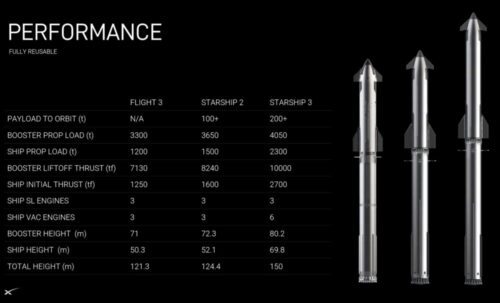
A comparison of the performance for three generations of Starship designs. Table shown by Elon Musk in Starbase talk on April 4th. Credit: SpaceX
- Catching a Super Heavy booster:
The update included near-term priorities for Starship that will unlock its ability to be fully and rapidly reusable, the core enabler for transforming humanity’s ability to send large amounts of payload to orbit and beyond pic.twitter.com/bkxS7fNSnt
— SpaceX (@SpaceX) April 6, 2024
- Bases on the Moon and Mars
What we’re building today will enable sending around a million people and several million tonnes to the Martian surface in the years to come → https://t.co/F8OOgqMFfh pic.twitter.com/FRrIJg6DXY
— SpaceX (@SpaceX) April 6, 2024
A couple of responses to Elon's talk:
- Elon Musk just gave another Mars speech—this time the vision seems tangible | Ars Technica - Apr.8.2024
- Elon Musk: New Details on Making Life Multiplanetary | Leonard David - Apr.8.2024
---- Update on lunar projects and orbital refueling
The propellant transfer test on third flight apparently went well according to Amit Kshatriya, the deputy associate administrator for NASA's Moon to Mars Program:
"He also noted that the inter-tank cryogenic propellant transfer test on the third Starship flight last month was successful by all accounts, although analysis of data from it is ongoing." - Jeff Foust on Twitter
Kshatriya provide two slides outlining the propellant transfer demonstration mission:
Starship "Target" and "Chaser" for the prop transfer (refilling) demo. pic.twitter.com/H6bJw1EO0w
— Chris Bergin - NSF (@NASASpaceflight) April 26, 2024
More on Kshatriya's discussion of Starship refueling:
- SpaceX making progress on Starship in-space refueling technologies | SpaceNews - Apr.27.2024
- NASA Updates on Starship Refueling, as SpaceX Prepares Flight 4 of Starship | NASASpaceFlight.com - Apr.28.2024
** Starship lunar landing demonstration mission will include liftoff from surface
Kshatriya said the Starship HLS uncrewed demo lunar landing mission now includes an ascent test to demonstrate the vehicle can lift back off.
— Jeff Foust (@jeff_foust) April 26, 2024
** Kshatriya confirmed the fourth flight test should happen in May:
NASA's Amit Kshatriya says at an advisory committee meeting this morning that the agency expects SpaceX to attempt its next Starship/Super Heavy test flight by the end of May.
— Jeff Foust (@jeff_foust) April 26, 2024
** SpaceX video of third test flight:
On March 14, 2024, Starship successfully lifted off at 8:25 a.m. CT from Starbase in Texas and went on to accomplish several major milestones and firsts.
Starship's six second stage Raptor engines all started successfully and powered the vehicle to its expected orbit, becoming the first Starship to complete its full-duration ascent burn. Starship went on to experience its first ever entry from space, providing valuable data on heating and vehicle control during hypersonic reentry. Live views of entry were made possible by Starlink terminals operating on Starship.
This rapid iterative development approach has been the basis for all of SpaceX’s major innovative advancements, including Falcon, Dragon, and Starlink. Recursive improvement is essential as we work to build a fully reusable transportation system capable of carrying both crew and cargo to Earth orbit, help humanity return to the Moon, and ultimately travel to Mars and beyond.
https://youtu.be/ApMrILhTulI
** "Ellie in Space" interview with Eric Berger, who is following up on his book Liftoff about the early days of SpaceX with a new book titled Reentry , which focuses on the development of the reusable Falcon 9 and its impact on the space industry.
Space journalist Eric Berger on SpaceX's Starship, Jeff Bezos, and more
Thank you for the interview, @SciGuySpace pic.twitter.com/93eS3wNN01
— Ellie in Space (@esherifftv) May 5, 2024
** The Space Show interviewed guest Christopher Prophet, who has written extensively about SpaceX.
https://thespaceshow.com/sites/default/files/shows/4183-BWB-2024-04-07.mp3
- Articles:
- Fourth flight test:
- Starship S29, Super Heavy Booster B11
- As IFT-4 prepares for launch, Starship’s future is coming into focus | NASASpaceFlight.com - Apr.19.2024
- Fifth flight test:
- Presumably with Starship S30, Super Heavy Booster B12
- Starship 30 Static Fire Test | SpaceX Boca Chica | NASASpaceFlight Youtube - May.8.2024
- Ship 30 set to Static Fire next week as Flight 4 Preparations Continue | NASASpaceFlight.com - May.5.2024
- Moving into the Thirties: What's New on Starship 30? | Ringwatchers - May.1.2024
- Construction Everywhere at The World's Busiest Spaceport | KSC Flyover | NASASpaceFlight Youtube - May.8.2024 - Includes views and updates on SpaceX facilities in support of Starship and Falcon 9.
- NASA may alter Artemis III to have Starship and Orion dock in low-Earth orbit | Ars Technica - Apr.22.2024
- Work Underway on Large Cargo Landers for NASA’s Artemis Moon Missions | NASA - Apr.19.2024
- SpaceX Reusable Starship Could Become Cheaper than Intercontinental Airplanes for Earth Cargo | NextBigFuture.com - Apr.2.2024
- Resources:
- Starship - SpaceX
- Starship's Third Flight Test - Mar.14.2024
- Starship's Second Flight Test - Nov.18.2024
- Starship Flight Test - Apr.20.2024
- Everyday Astronaut - Flight reviews
- Starship/Super Heavy | Integrated Flight Test #3 - March 14, 2024 - Starship S28, Booster B10
- Starship/SuperHeavy | Integrated Flight Test #2 - Nov. 18, 2023 - Starship S25, Booster B9
- Starship/SuperHeavy | Starship Flight Test - April 20, 2023 - Starship S24, Booster B7
- Tony Bela - Infographic news (@InfographicTony) / X
- Integrated Flight Test - 3 Infographic
- Integrated Flight Test - 2 Infographic
- Ryan Hansen Space (@RyanHansenSpace) / X - Photorealistic graphics and animations
- Starship SpaceX Wiki | Fandom
- Ringwatchers
- Something New: What's the Hardware Status of Starship Version 2? - Apr.14.2024
- Video reports and webcams:
- LabPadre at YouTube, live webcams
- RGV Aerial Photography - YouTube
- NASASpaceflight at YouTube, live webcams
- Marcus House - YouTube
- What about it!? - YouTube
- CSI Starbase - YouTube
- Starship Gazer - YouTube
For lots of background info on Starship, see the SpaceX Starship report, which is published by NewSpace Global and for which I was the primary author. The initial version came out in March 2023 and then we updated it in May 2023 to include coverage of the first flight test.
==================
Check out the
The Lurio Report
for news and analysis of key developments in NewSpace
The latest issue:
Starlink’s Progress, Vulcan, Moon Landing Attempts
Vol. 19, No. 1, February 2, 2024
Space Frontier Foundation Award for NewSpace Journalism
==================
** SpaceX Falcon Rockets & Dragon Spacecraft
--- Falcon 9 booster achieves 20 flights for the first time.
Read the full article
0 notes
Text
Lunar Codex
I am privileged to share that mention of and images of my work have been included in the Lunar Codex.
The Lunar Codex is the passion project of physicist, entrepreneur, and storyteller Samuel Peralta, who alongside NASA’s Artemis Program has placed a record of contemporary creative works from “35,000 artists, writers, musicians, and filmmakers, representing 234 countries, territories, and Indigenous nations, in time capsules launching from Earth to the Moon and beyond.” *
Read more about the Lunar Codex here.
My work was included in two issues of magazines that have been gathered into the the Lunar Codex using digital and analog technology:
50 MEMORABLE PAINTERS
published by GOSS183 in 2015
Special PA (PoetsArtists) issue curated by John Seed and Didi Menendez
Featuring art from:
Alexsander Betko ▪ Jeffrey Bess ▪ Charis Carmichael Braun ▪ Ali Cavanaugh ▪ Matthew Ivan Cherry ▪ Erica Elan Ciganek ▪ Ben Cressy ▪ Gabriela G. Dellosso ▪ Emanuela De Musis ▪ Shawn Fields ▪ Ron Francis ▪ Zoey Frank ▪ Patrick Earl Hammie ▪ Graham Harwood ▪ Mark Heine ▪ Erika B. Hess ▪ Jen Hitchings ▪ Milan Hrnjazovic ▪ Karen Kaapcke ▪ Michael Kozlowski ▪ Valeri Larko ▪ Brianna Lee ▪ Kim Leutwyler ▪ Shana Levenson ▪ Zachari Logan ▪ Susannah Martin ▪ Renee McGinnis ▪ Darian Rodriguez Mederos ▪ Sylvia Maier ▪ Shie Moreno ▪ Rachel Moseley ▪ Judith Peck ▪ John Philbin Dolan ▪ Serena Potter ▪ Nadine Robbins ▪ Beverly Rippel ▪ Cesar Santos ▪ Victoria Selbach ▪ Ed Smiley ▪ Kyle Staver ▪ Barry Smith ▪ Albert Leon Sultan ▪ Emily Thompson ▪ Alexandra Tyng ▪ Conor Walton ▪ Nick Ward ▪ Thomas Wharton ▪ Margaret Withers ▪ Meg Wolensky ▪ Stephen Wright
Vehicle(s) and launch dates:
Peregrine / PM1 - NASA CLPS-TO2-AB / Astrobotic Peregrine Mission 1 (Jan 8-18, 2024); Polaris / GM1 - NASA CLPS-TO-20A (VIPER) / Astrobotic Griffin Mission 1 (Nov 2024).
POETSARTISTS #57
published by GOSS183 in September 2014
curated by Didi Menendez
Featuring:
Poets : Leila Ammar ▪ Jan Ball ▪ Nin Andrews ▪ P.H. Davis ▪ Carlton Fisher
Artists : cover photo of Bryce Ramming by Michael Auer ▪ Jorg Dubin ▪ Charis J. Carmichael Braun ▪ Alvin Richard ▪ Tristan Pigott ▪ Eric Daniel Almanza ▪ Shawn Huckins
Collaborations : Paul Beel & Grace Cavalieri ▪ Kate Lutzner & Victoria Selbach ▪ Angela Hardy & Lorraine Currelley ▪ Daniel Maidman & Nin Andrews ▪ Judith Peck & Pris Campbell ▪ Robbie Robb & Larry Lawrence ▪ Judith Peck & Robert Lee Brewer ▪ Debra Livingston & R. J. Slais ▪ James Needham & Melissa McEwen ▪ Jeff Faerber & Denise Duhamel ▪ Matt Calavecchia & Ken Taylor ▪ Debra Balchen & Laurie Kolp ▪ Cesar Conde & Duriel Harris ▪ Timothy Robert Smith & Bill Yarrow
Vehicle and launch date:
Polaris / GM1 - NASA CLPS-TO-20A (VIPER) / Astrobotic Griffin Mission 1 (Nov 2024).
Incandence Corp., “The Lunar Codex: Story.” LunarCodex.com, 24 April 2024, https://www.lunarcodex.com/story
0 notes
Text
The Space Sensors and Actuators Market is projected to grow from USD 2.7 Billion in 2022 to USD 4.9 Billion by 2027, at a CAGR of 12.7% from 2022 to 2027. Significant investments in the space industry by private players, such as SpaceX, Astrobotic Technology, Blue Origin, iSpace, and Northrop Grumman Corporation, are driving the Space Sensors and Actuators Industry. Factors such as advancements in robotic technology, efficient propulsion, lower mission costs, availability of commercial-off-the-shelf components, and other technological advancements have trimmed the costs of space launches. This has enabled the preparation and launch of space missions at affordable prices, thus attracting the interest of private companies. The development of cost-effective components using technologies such as additive manufacturing and the increasing space exploration budgets of emerging countries have also contributed to the growth of the space sensors and actuators market for planetary exploration.
#Space Sensors and Actuators#Space Sensors and Actuators Market#Space Sensors and Actuators Industry#Global Space Sensors and Actuators Market#Space Sensors and Actuators Market Companies#Space Sensors and Actuators Market Size#Space Sensors and Actuators Market Share#Space Sensors and Actuators Market Growth#Space Sensors and Actuators Market Statistics
0 notes
Text
Новости Сиэтла - 17-02-2024
Окончательный подсчет НАСА показывает, что космический аппарат вернул в два раза больше обломков астероида.
Космический аппарат НАСА «Осирис-Рекс» превзошел ожидания, вернув вдвое больше обломков астероида Бенну, чем планировал. Космический аппарат собрал 121,6 грамма пыли и гальки, что является самым крупным космическим уловом из-за пределов Луны. Образцы, богатые углеродом, впервые были собраны НАСА с астероида и сейчас хранятся в специальной лаборатории в Хьюстоне. Несмотря на некоторые трудности с застрявшими креплениями, что затянуло процесс открытия контейнера с образцами, миссия была успешной. Теперь космический аппарат направляется к другому космическому камню для пролета мимо него без сбора образцов.
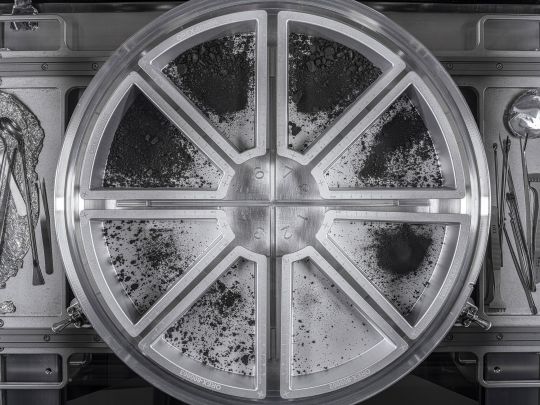
Источник: https://www.seattletimes.com/seattle-news/science/nasas-final-tally-shows-spacecraft-returned-double-the-amount-of-asteroid-rubble/
Стюардесса, которая спасла 6 яиц фламинго, позже встречает птенцов.
В Сиэтле произошла трогательная история, когда стюардесса Alaska Airlines по имени Эмбер Мэй была попросена помочь сохранить теплоту шести нежных яиц чилийских фламинго во время рейса из Атланты в Сиэтл. Инкубатор, в котором яйца транспортировала сотрудница зоопарка, вышел из строя, поставив под угрозу судьбу яиц. Мэй с помощью пассажиров создала импровизированное гнездо, используя теплые перчатки, наполненные теплой водой, чтобы обеспечить выживание яиц. Спасительные действия и доброта Мэй и пассажиров оказались успешными, и четыре самки и два самца успешно вылупились в зоопарке Woodland Park в Сиэтле. Эти новые прибавления имеют важное значение для популяции фламинго в зоопарке, способствуя их репродуктивному успеху. Чилийские фламинго являются видом, который находится под угрозой и сталкивается с проблемами, такими как потеря среды обитания, загрязнение и незаконное собирательство яиц. Зоопарк надеется, что эти новые фламинго привлекут внимание к усилиям по сохранению и помогут увеличить популяцию стада, особенно учитывая, что многие старые фламинго больше не размножаются. Этот трогательный случай не только спас жизни птенцам фламинго, но также подчеркнул важность защиты этих красивых птиц.

Источник: https://www.seattletimes.com/seattle-news/flight-attendant-who-saved-6-flamingo-eggs-later-meets-chicks/
SpaceX запускает то, что может стать первым успешным коммерческим лунным посадочным модулем.
В Сиэтле компания SpaceX успешно запустила ракету Falcon 9 с лунным посадочным модулем Nova-C компании Intuitive Machines под названием Одиссей в рамках миссии IM-1. Ракета взлетела с площадки 39-A Центра космических полетов имени Кеннеди после задержки из-за проблем с загрузкой криогенного метана. Цель миссии - достичь первой коммерческой мягкой посадки на Луну с запланированным прибытием 22 февраля. Первая ступень совершила свой 18-й полет и приземлилась на станции Военно-космических сил на мысе Канаверал. Этот запуск стал девятым и десятым орбитальными полетами с космического побережья в 2024 году, преимущественно осуществляемыми SpaceX.
Посадочный модуль Nova-C успешно отделился от второй ступени и установил связь для ее транслунного ввода. Эта миссия является частью программы Commercial Lunar Payload Services (CLPS) НАСА, в рамках которой Intuitive Machines заключила контракт на три запуска. Посадочный модуль компании оборудован для перевозки 220 фунтов груза, причем шесть из 12 полезных нагрузок на борту направлены к южному полюсу Луны. Программа CLPS направлена на развитие лунной экономики через привлечение частных компаний для выполнения лунных миссий, что позволит НАСА сконцентрироваться на пилотируемых миссиях в рамках программы "Артемида".
Руководитель программы CLPS в NASA выразил оптимизм относительно успешности миссии Intuitive Machines, подчеркнув трудности посадки на Луну. Эта миссия является второй из пяти запланированных на 2024 год запусков CLPS, сразу за предыдущей попыткой Astrobotic Technology, столкнувшейся с трудностями. Успешная посадка Intuitive Machines станет значимым событием в частной космической деятельности, продемонстрировав возможности коммерческих структур в выполнении лунных миссий с минимальным вмешательством со стороны НАСА.
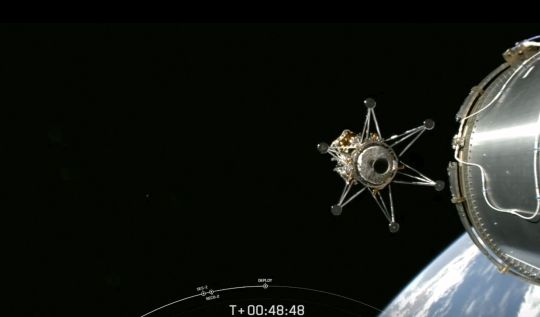
Источник: https://www.seattletimes.com/business/boeing-aerospace/spacex-launches-what-could-become-1st-successful-commercial-lunar-lander/
0 notes
Text
Just Because You Can Pay to Have Your Ashes Buried on the Moon Doesn't Mean You Should - Technology Org
New Post has been published on https://thedigitalinsider.com/just-because-you-can-pay-to-have-your-ashes-buried-on-the-moon-doesnt-mean-you-should-technology-org/
Just Because You Can Pay to Have Your Ashes Buried on the Moon Doesn't Mean You Should - Technology Org
Sending human ashes and personal mementoes to the Moon is now possible, but it opens up a maze of legal and ethical conundrums.
When NASA attempted to return to the Moon for the first time in 50 years, more was at risk than just US$108 million worth of development and equipment.
The Moon is smaller than Earth, and this fact is also one of the reasons why its gravity is not sufficient to retain any atmospheric gases near its surface. Image credit: NASA
The agency earned the ire of the Native American Navajo people, who made a bid to stop the launch because of an unusual inclusion in the payload.
The Peregrine lander (which completed its controlled re-entry into the atmosphere late last week) carried human ashes, including those of famed science fiction author Arthur C. Clarke. A commercial partnership also allowed paying customers to send their mementos to the Moon.
As space exploration becomes increasingly privatised and commercial, you can now send your favourite stuff to the Moon. But what does that mean, both ethically and legally?
The Moon open for business
US company Astrobotic owns the Peregrine, which is the size of a small car. It ran into fatal fuel issues shortly after being launched on Vulcan Centaur rocket from Cape Canaveral.
On board are “vanity canisters”. The idea arose in a partnership between the firm and global freight company DHL.
Under the deal, anyone can send two and a half centimetre by five centimetre package to the lunar surface for less than US$500. Apart from size, there were a few other limitations on what each package could contain.
Astrobotic, founded in 2007 and based in Pittsburgh, Pennsylvania, is one of several US companies providing commercial lunar payload services to NASA to deliver science and technology to the Moon. Peregrine was also carrying scientific instruments from six countries and many science teams.
Perhaps surprisingly, sending ashes into space is not new aboard suborbital and Earth orbital flights.
Two American companies make a business of the service starting at just a few thousand dollars – Celestis and Elysium Space. The practice is embraced by many, including astronauts who have been in space.
A Moon burial (yes, you can buy one) costs more – around US$13,000.
Commercial payloads launched from US soil require approval, but that approval process only covers safety, national security, and foreign policy.
Peregrine, if it had made it, would have marked the first commercial lunar burial. It’s uncharted territory as other worlds become within reach, although it is not the first time it has come up.
NASA pledged to consult in the future after an outcry from the Navajo when, 20 years ago, it carried some of Eugene Shoemaker’s ashes to the Moon aboard the Lunar Prospector probe. Like many other indigenous cultures, the Navajo Nation considers the Moon sacred and opposes using it as a memorial site.
However, NASA said in a press briefing it had no control over what was on Peregrine, highlighting the gaps between commercial enterprise and international space law.
A legal minefield
Another question concerns the rules in individual nations on where and how human ashes can be located, handled, and transported and how those could extend to space. For example, in Germany, ashes must be buried in a cemetery.
With space privatisation accelerating, the ethical and legal maze deepens.
The Outer Space Treaty (OST) declares space the “province of all mankind” while banning national appropriation.
It fails, however, to address what private companies and individuals can do.
The recent Artemis Accords, signed by 32 nations, expand protection to lunar sites of historical significance. But these protections only apply to governments, not commercial missions.
And no one owns the Moon to grant burial rights, or any other world or celestial body.
The treaty requires states to authorise and supervise activities in space. It requires “due regard” for the interests of other states.
Many countries have space law that includes grounds for refusing payload items not in their national interest, for example Indonesia and New Zealand.
Nations apparently without such consideration, including Australia and the US, may need to consider expanding this template with the emergence of the commercial world in a traditionally governmental arena.
Where to draw a line?
Earth’s orbit is already clogged with defunct satellites and, further out, items like Elon Musk’s Tesla.
According to space archaeologist Alice Gorman, we have already spread space probes across other worlds, including the Moon, Mars, Titan, and Venus, but much may be treasure rather than junk.
For example, the Apollo astronauts left official mementos, such as a plaque marking the first human footsteps on the lunar surface. Some have left personal ones, too, like Apollo 16’s Charles Duke, who left a framed family photo.
However, sending a clipping of your hair or the ashes of your pet dog to the Moon may not qualify as culturally and historically important.
The problem, therefore, is where we want to place a line in the sand as we step out into the cosmos onto the shorelines of other worlds.
We cannot turn back the clock on private space enterprise, nor should we.
But this failed mission with ashes and vanity payloads exemplifies the unexplored questions in the legal and ethical infrastructure to support commercial activities.
It is worth pausing for thought on future commercialisation such as mining asteroids and the eventual colonisation of space.
Source: UNSW
You can offer your link to a page which is relevant to the topic of this post.
#000#asteroids#astronauts#Astronomy news#atmosphere#Australia#board#Business#Companies#cosmos#deal#development#dog#earth#earth's moon#Elon Musk#enterprise#equipment#Featured Space news#fuel#Future#Germany#Global#gravity#how#human#Image of the week#inclusion#Infrastructure#issues
1 note
·
View note
Link
0 notes